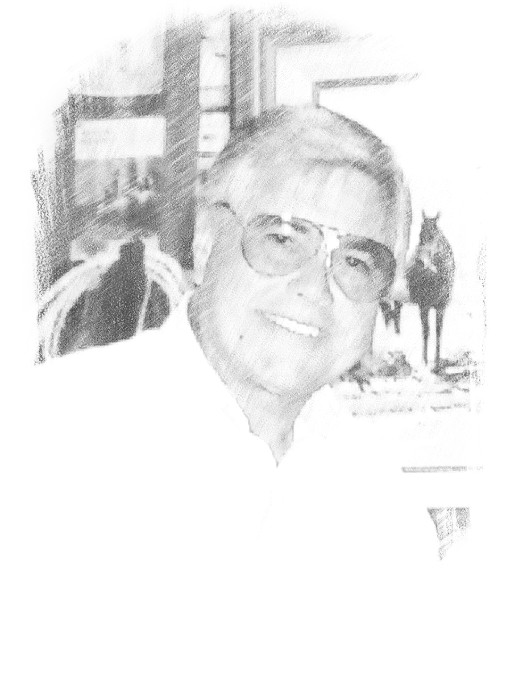
Fred Fellows, CA Emeritus
(b. 1934)
Fred Fellows was born in 1934 in Ponca City, Oklahoma, home to the Ponca and Osage Indians. Early influences that shaped his desire to be an artist and nurtured his love of the cowboy life included his aunt who went to Taos, New Mexico every summer to study under Nicolai Fechin and Birger Sandzen. She encouraged Fred to draw and paint at an early age. He also grew up listening to stories of the Old West from his grandmother’s brother who rode in Buffalo Bill’s Wild West Show and later the 101 Ranch Wild West Show, as well as his grandfather who went to Tonopah and Goldfield, Nevada, during the 1905 gold rush.
Fred started out as a saddle-maker for Butler Saddlery in Paramount, California, and went on to be a cowboy on the Jamison Ranch at Monolith, California, and then an art director for Northrup Aircraft. This all led to an interesting blend of art and the West, and a lifetime of painting and sculpting.
Fred is the longest active member of the CAA, joining in 1969. He has won Gold and Silver medals in drawing, sculpture and painting. One of his proudest moments was to receive the highly coveted CAA Award at the 2007 show, voted by active members for the best overall exhibition.
He also is proud of his wife, Deborah, an accomplished sculptor, who is a member of the National Sculpture Society and inductee into the National Cowgirl Hall Museum and Hall of Fame in Fort Worth, Texas.
Source: The Cowboy Artists of America

Out to Pasture
Artist: Fred Fellows, CA Emeritus (b. 1934)
Description: Oil (2006) | Image Size: 30”h x 40”w; Framed Size: 41 ½”h x 51 ½”wpainting
One of the themes that Emeritus Member of the Cowboy Artists of America Fred Fellows explores in his art is the transition of the Old West to the new. Here he presents a nostalgic scene that emphasizes that theme; both the old worn red truck and the horse have seen better days. As the title suggests, they have been put out to pasture. Both represent a time that has passed and both no doubt could tell more than a few stories if they could talk. The tone and mood of the painting is somewhat wistful, but Fellows also shows that while these two are not in pristine condition, they still survive and stand side by side.
Fellows’ masterworks, oil paintings and bronzes, can be found in museums and private collections worldwide. For more information, visit his website at https://fellowsstudios.com/
Half the Battle
Artist: Fred Fellows, CA Emeritus (b. 1934)
Description: Bronze (1998) | Dimensions: 12”h x 19”w x 7”dbronze
With as much time as Fred Fellows has spent in the saddle and by bringing that knowledge into his work, he achieves a true sense of authenticity in his bronzes. On the Fellows Studios website, he shares “A cowboy that ropes a thousand-pound horse has his work cut out for him. Just getting his rope on the horse is half the battle. Dealing with the ensuing fight is the rest of the battle.”
What are your thoughts when you ponder the enormity of that task?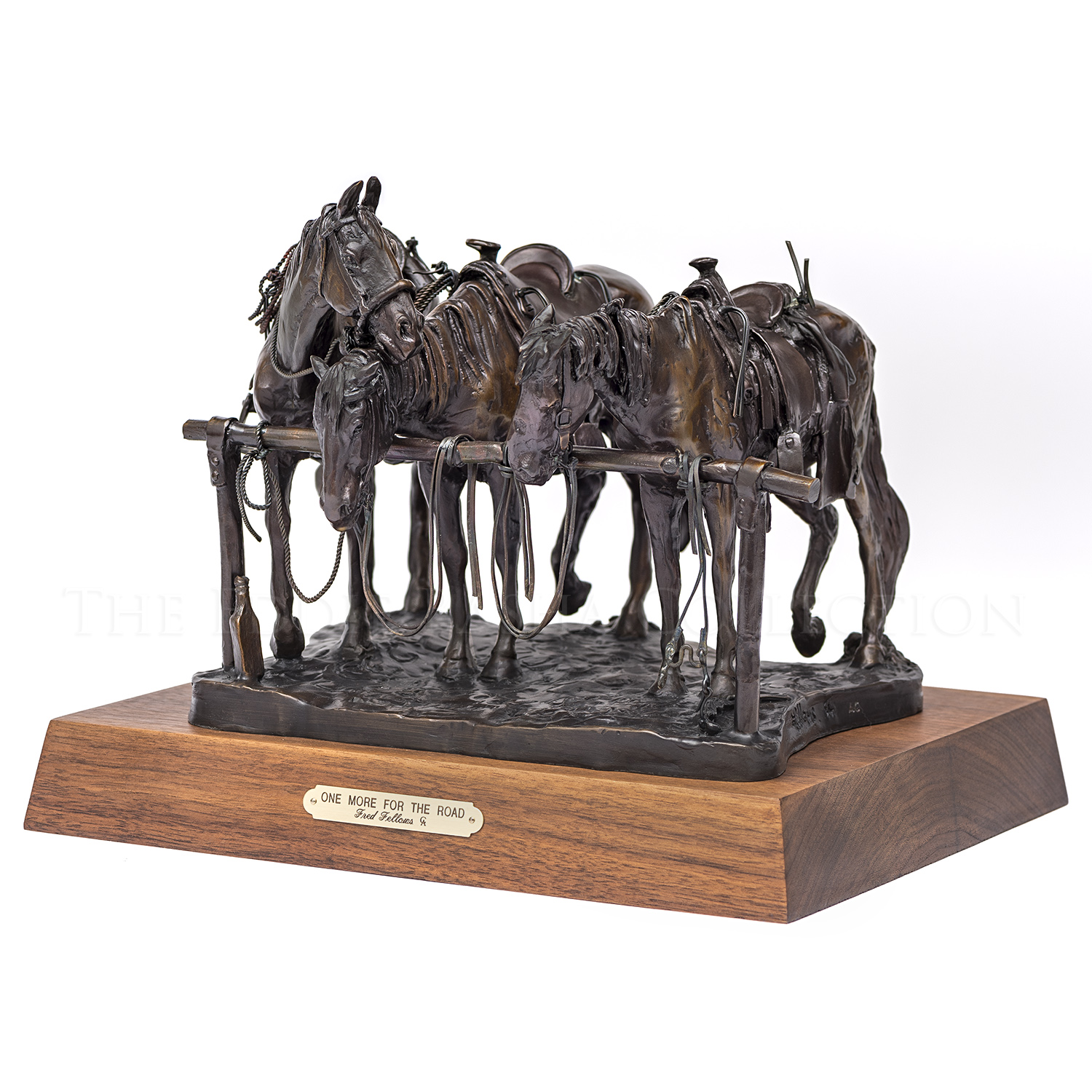
One More for the Road
Artist: Fred Fellows, CA Emeritus (b. 1934)
Description: Bronze (1995) | Dimensions: 10”h x 12 ½”w x 10 ½” d; Edition ACbronze
Fred Fellows has worked with horses in some capacity or another much of his life and is adept at capturing their moods, subtle nuances and personalities. Here, Fred Fellows shows three cow ponies tied to a hitching post with the one on the far left seemingly reaching toward the other horses as if to intimate that perhaps their riders were having “One More for the Road.”
Swan River Crossing
Artist: Fred Fellows, CA Emeritus (b. 1934)
Description: Oil (1978) | Image Size: 20”h x 30”w; Framed Size: 30 ¼”h x 40 ¼”wpainting
Painting water realistically and effectively is a very difficult task for an artist. It entails capturing the reflective nature of the surface and imparting a feeling of depth which are challenging exercises. Fred Fellows has done so splendidly in this painting of a cowboy and his horses crossing the river. Fellows uses several cool tones of greens and blues to give just the right feel to this winter scene. The rider and horses comprise most of the scene, but the primary features are the beauty of the river and Fellow’s skillful hand at portraying it.
When the Honeymoon’s Over
Artist: Fred Fellows, CA Emeritus (b. 1934)
Description: Bronze (1994) | Dimensions: 14”h x 10”w x 5”d; Edition #38 of 100bronze
“Sometimes a cowboy falls in love with a horse and it’s more than he bargained for. When he hits the ground, the honeymoon’s over,” shared Fred Fellows.
Fellows has spent many years as a cowboy and has had the opportunity to observe modern ranch hands for most of his life. A cowboy trying to stay in the saddle on an ornery horse is one of his favorite subjects, one that he handles with an authentic touch and a sense of humor. This particular casting has a rich and lustrous brown patina.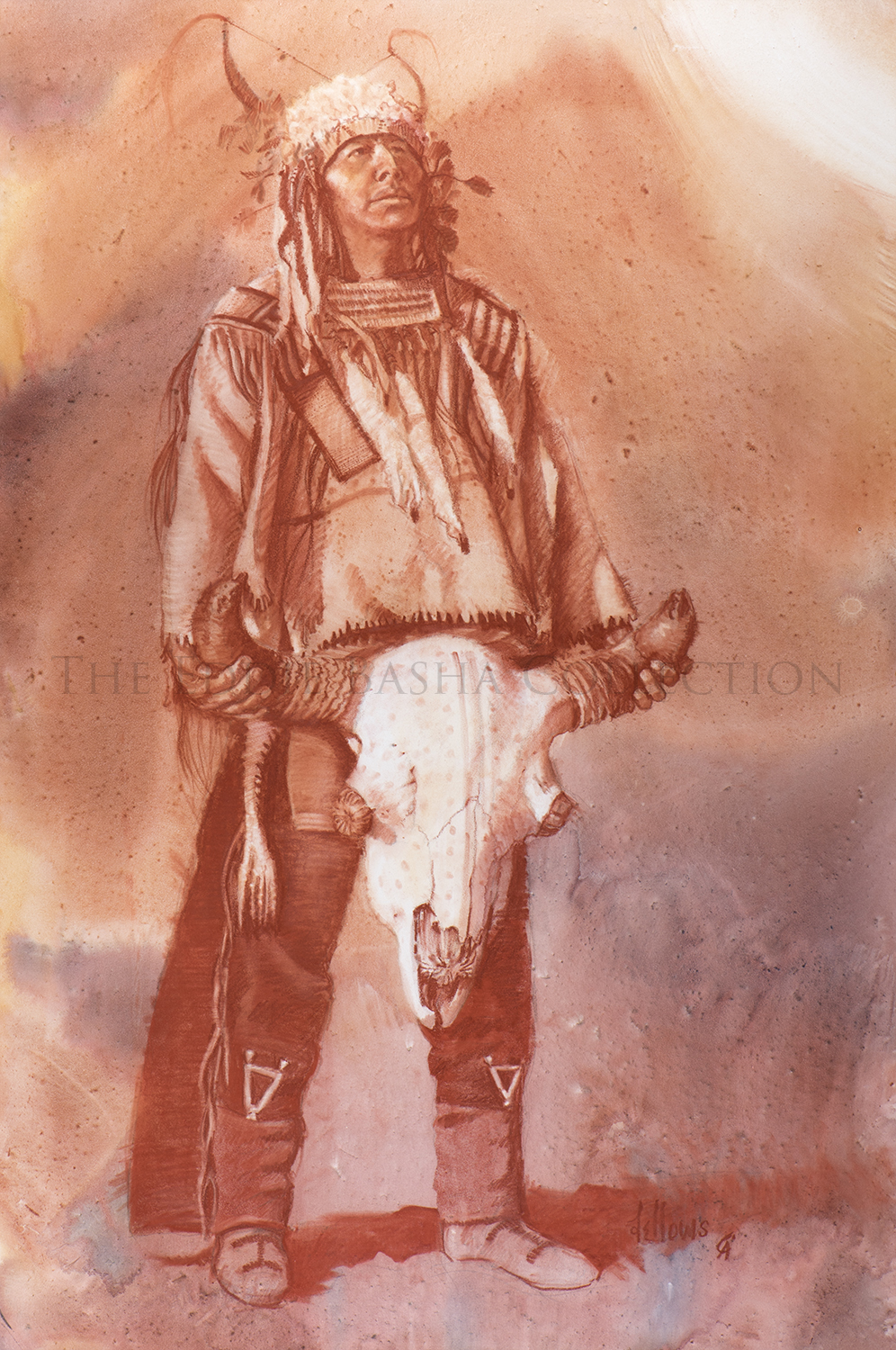
Blessing the Sundance Skull
Artist: Fred Fellows, CA Emeritus (b. 1934)
Description: Pastel (2004) | Image Size: 36”h x 24”w; Framed Size: 46”h x 34”wpastels
One of the most important rituals practiced by many Northern Plains tribes was the Sundance. In this well done pastel, Fred Fellows presents an Indian wearing a buffalo horn headdress and beaded buckskins preparing to participate in the dance. He holds a sacred buffalo skull which will be an important part of the ritual. The warrior is facing the rising sun. He is drawn in great detail and set against a flat background that serves to emphasize his presence.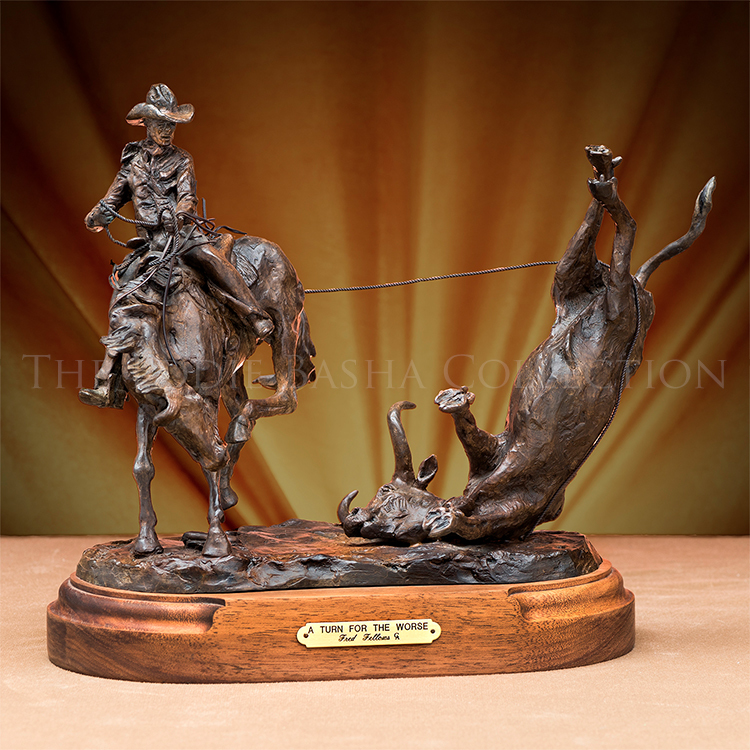
A Turn for the Worse
Artist: Fred Fellows, CA Emeritus (b. 1934)
Description: Bronze (1996) | Dimensions: 12”h x 15”w x 9”d; Edition #29 of 100bronze
Having competed in numerous roping competitions, Fred Fellows has a unique insight into creating truly authentic depictions of both the modern and historic west. “A Turn for the Worse” first debuted at the 31st Annual Cowboy Artists of America Show & Sale in 1996 at the Phoenix Art Museum. He and his wife Deborah, an acclaimed artist as well, live on their ranch in Arizona.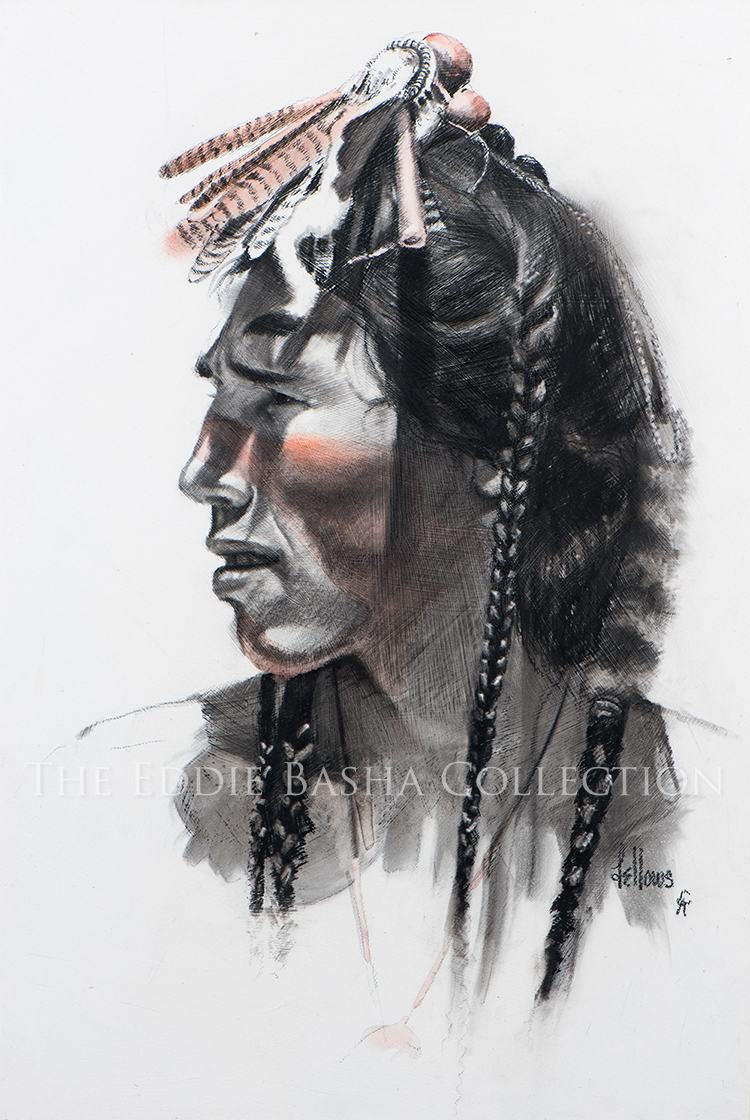
His War Medicine
Artist: Fred Fellows, CA Emeritus (b. 1934)
Description: Charcoal (1989) | Image Size: 23”h x 16”w; Framed Size: 33 ¾”h x 26 ½”wdrawing
“His War Medicine” is an excellent charcoal portrait of a Plains Indian. Shown in profile, the subject’s face is well delineated. Fellows has skillfully drawn a likeness that projects an individual and unique personality with authentic and historically accurate detail.
Paniolo Saddle
Artist: Fred Fellows, CA Emeritus (b. 1934)
Description: Bronze (1985) | 10”h x 7”w x 7”d; Edition #21 of 50bronze
In Ke Ola, Hawai‘i Island’s Community Magazine, Denise Laitinen wrote, “the paniolo, a Hawaiian cowboy, on Hawai‘i Island date back to 1833 when three vaqueros—Spanish/Mexican cowboys—arrived at Kawaihae Harbor to teach Hawaiians how to rope and herd cattle and ride mounted horses. Over the years the paniolo developed their own style of saddle making—known as the Hawaiian tree saddle—so named because cowboys went into the forest and cut the tree, which they carved into a saddle.
And because Mexican saddles were heavy and bulky, the natural instinct of the Hawaiians was to use lighter materials. Thus, they refined the seat to make it concave which was a better fit for its riders’ buttocks. The prototype originated in the early 1900’s and has changed little in the past century. Native Hawaiians came up with a model that was hard to improve upon.”
Fred Fellows, learned early on in life how to ride, rope cattle and build saddles. Given his background, it was only fitting that he sculpted a saddle series which included those used by the Paniolo.
End of a Love Affair
Artist: Fred Fellows, CA Emeritus (b. 1934)
Description: Bronze | Dimensions: 9”h x 8”w x 7’d; Artist Proofbronze
Horses and men can be a beautiful combination or they can be a disaster depending upon the rider’s skill and horse temperament. Fred Fellow’s “End of a Love Affair” shows an unlucky cowboy who has met a common fate, being bucked off an unruly mount. The cowboy has literally been turned topsy-turvy while his horse continues to buck. Fellows, with a background in ranch work, knows this predicament well and has captured the action with a flair for the dramatic.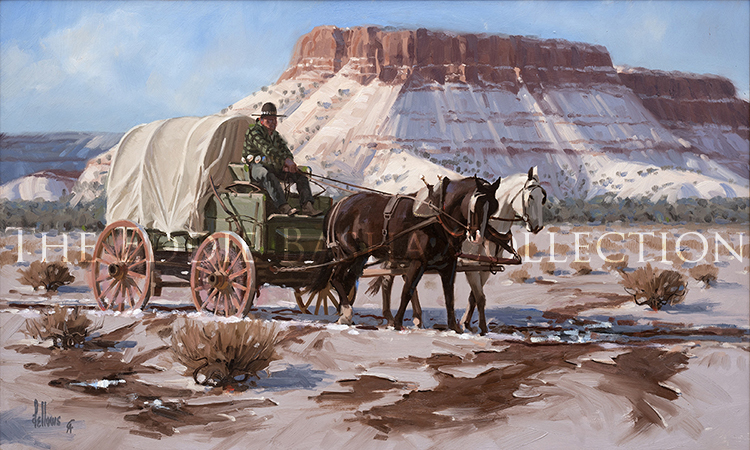
A Trip to the Trading Post
Artist: Fred Fellows, CA Emeritus (b. 1934)
Description: Oil (2008) | Image Size: 18”h x 30”w; Framed Size: 25 3/8”h x 37”wpainting
One of Fred Fellows favorite themes is the different modes of transportation in the historic and modern West. He frequently paints stage coaches, chuck wagons, freight wagons, and in this case, a covered wagon that will haul provisions from a desert trading post. The painting shows a wagon drawn by two horses traveling across an expanse of desert with a butte in the distance. The Navajo driver is bundled up against the winter chill as was Fred Fellows when he captured the image with his camera which he later painted back in the warmth of his studio. It is a simple scene, but is an important part of the life on a reservation.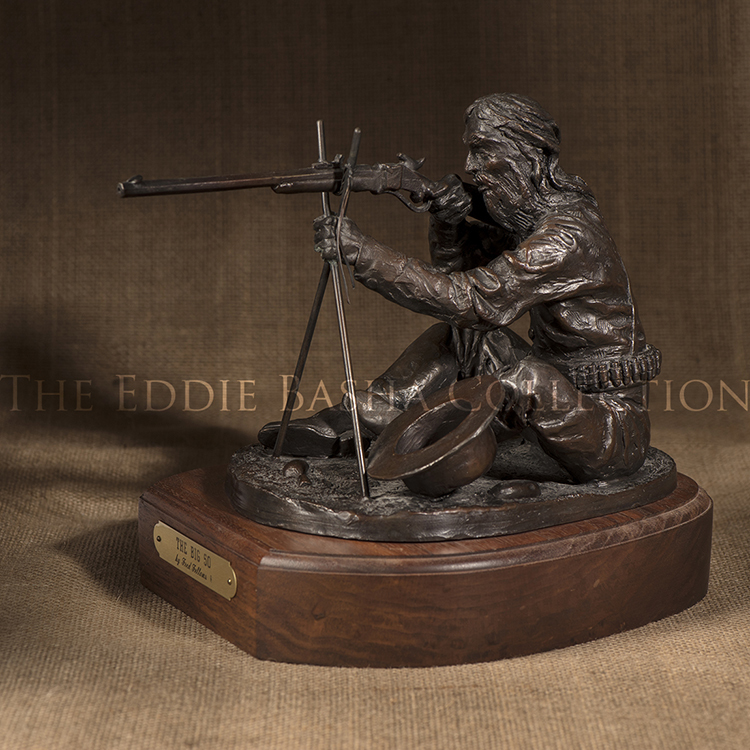
The Big 50
Artist: Fred Fellows, CA Emeritus (b. 1934)
Description: Bronze | 9”h x 8”w x 9”d; Edition #39 of 100bronze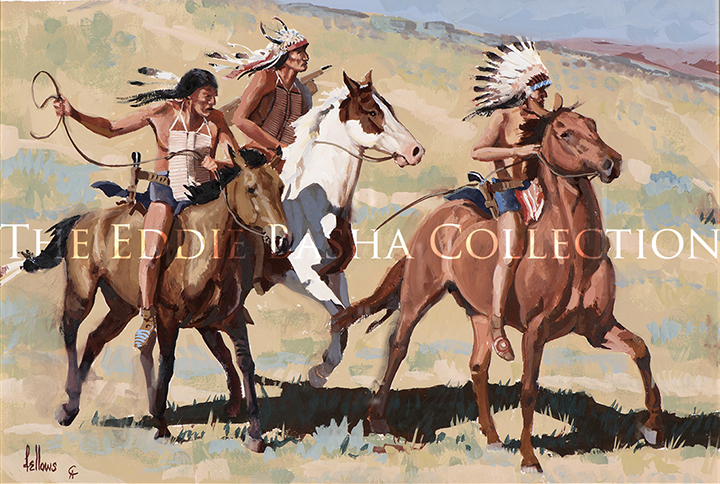
To Fight Custer
Artist: Fred Fellows, CA Emeritus (b. 1934)
Description: Opaque Watercolor (2005) | Image Size: 13” x 19”; Framed Size: 28 ¼”w x 22 ¾”hpainting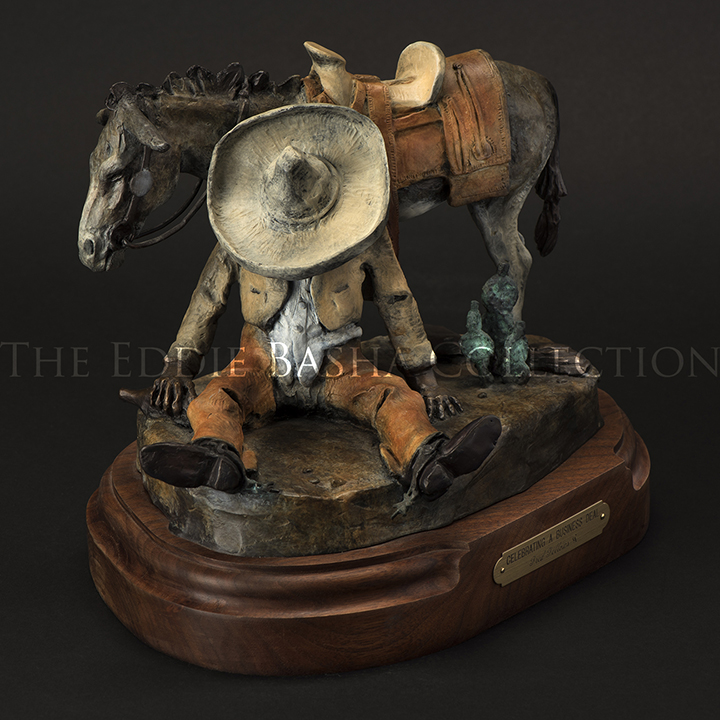
Celebrating a Business Deal
Artist: Fred Fellows, CA Emeritus (b. 1934)
Description: Bronze | 7.5” x 8” x 12”; Edition #31 of 100bronze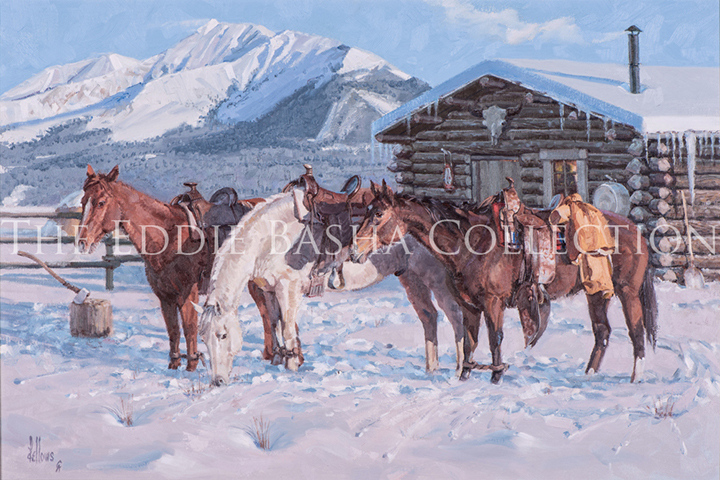
Friends for Supper
Artist: Fred Fellows, CA Emeritus (b. 1934)
Description: Oil Painting (2008) | Image Size: 24”h x 36”w; Framed Size: 34.25”h x 46.25”wpainting
Cowboy Artists of America Emeritus Member, Fred Fellows, knows his way around a working ranch and he also knows horse flesh. Both in his bronzes and in his paintings, he expertly captures the muscle tone and confirmation of the horses he portrays. He is equally adept at depicting horses in action or in quiet repose, such as in this scene of three horses waiting in the snow outside a cabin in the mountains. He also excels in this scene at showing the way light reflects off the snow to produce a luminous effect.
“Friends for Supper” made its debut at the 43rd Annual Cowboy Artists of America Show & Sale in 2008 at the Phoenix Art Museum.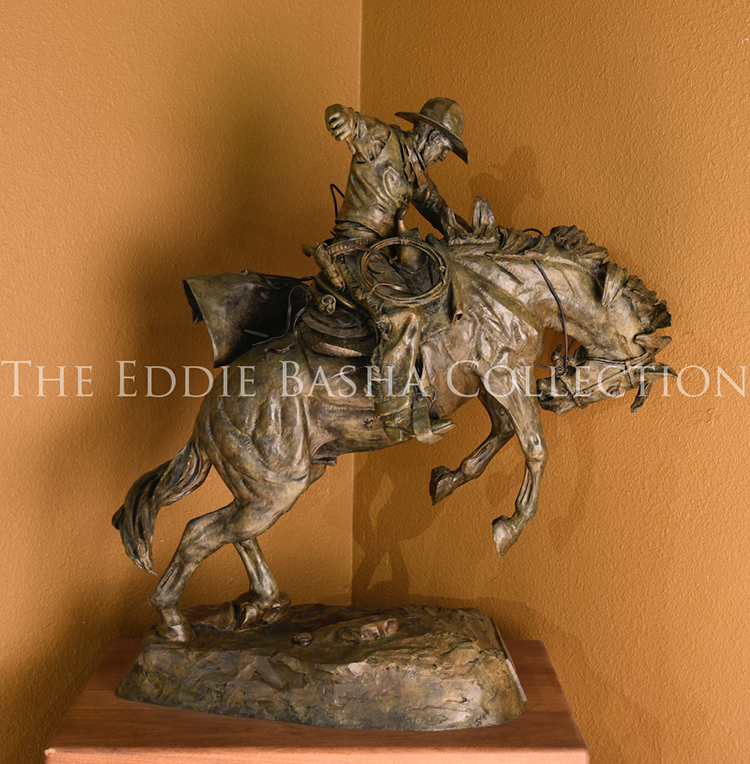
An Honest Day's Work
Artist: Fred Fellows, CA Emeritus (b. 1934)
bronze
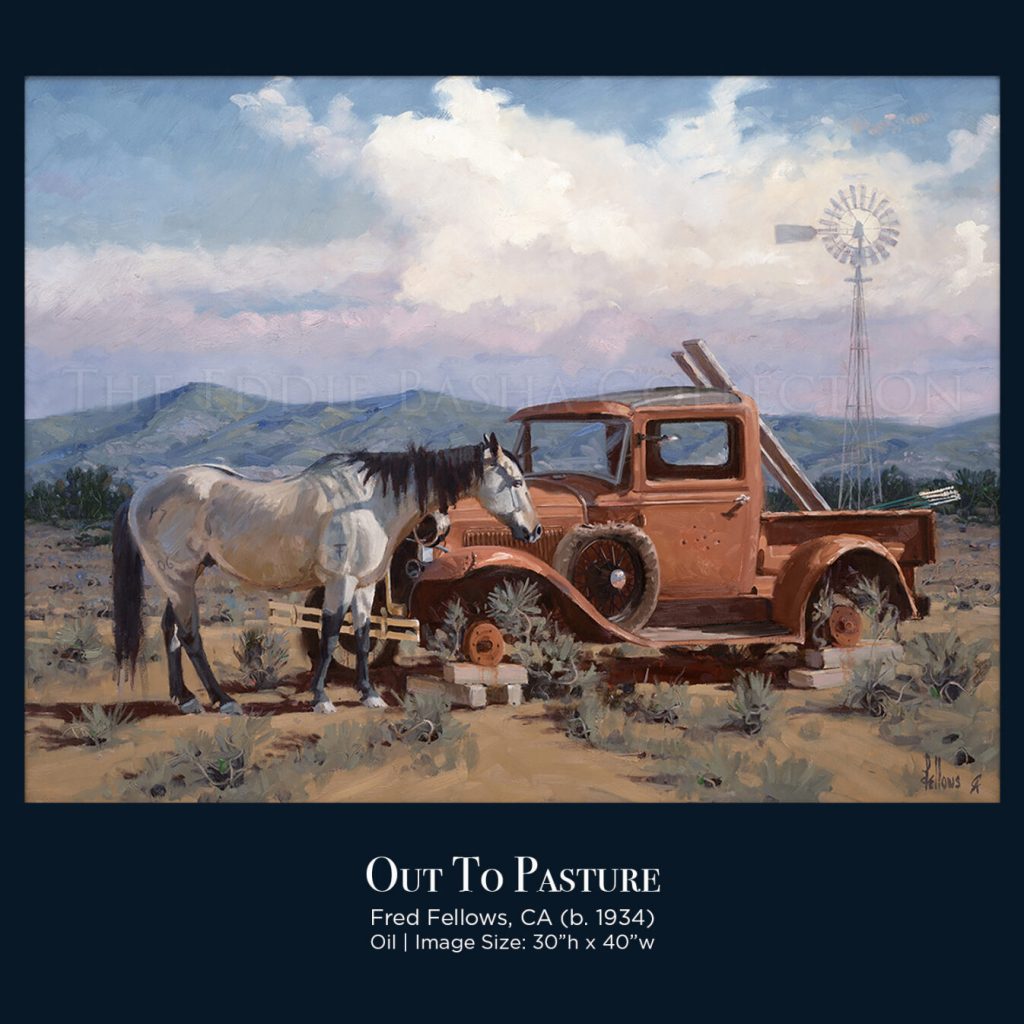 Oil (2006) | Image Size: 30”h x 40”w; Framed Size: 41 ½”h x 51 ½”w
Oil (2006) | Image Size: 30”h x 40”w; Framed Size: 41 ½”h x 51 ½”wOne of the themes that Emeritus Member of the Cowboy Artists of America Fred Fellows explores in his art is the transition of the Old West to the new. Here he presents a nostalgic scene that emphasizes that theme; both the old worn red truck and the horse have seen better days. As the title suggests, they have been put out to pasture. Both represent a time that has passed and both no doubt could tell more than a few stories if they could talk. The tone and mood of the painting is somewhat wistful, but Fellows also shows that while these two are not in pristine condition, they still survive and stand side by side.
Fellows’ masterworks, oil paintings and bronzes, can be found in museums and private collections worldwide. For more information, visit his website at https://fellowsstudios.com/
Out to Pasture
Artist: Fred Fellows, CA Emeritus (b. 1934)
One of the themes that Emeritus Member of the Cowboy Artists of America Fred Fellows explores in his art is the transition of the Old West to the new. Here he presents a nostalgic scene that emphasizes that theme; both the old worn red truck and the horse have seen better days. As the title suggests, they have been put out to pasture. Both represent a time that has passed and both no doubt could tell more than a few stories if they could talk. The tone and mood of the painting is somewhat wistful, but Fellows also shows that while these two are not in pristine condition, they still survive and stand side by side.
Fellows’ masterworks, oil paintings and bronzes, can be found in museums and private collections worldwide. For more information, visit his website at https://fellowsstudios.com/
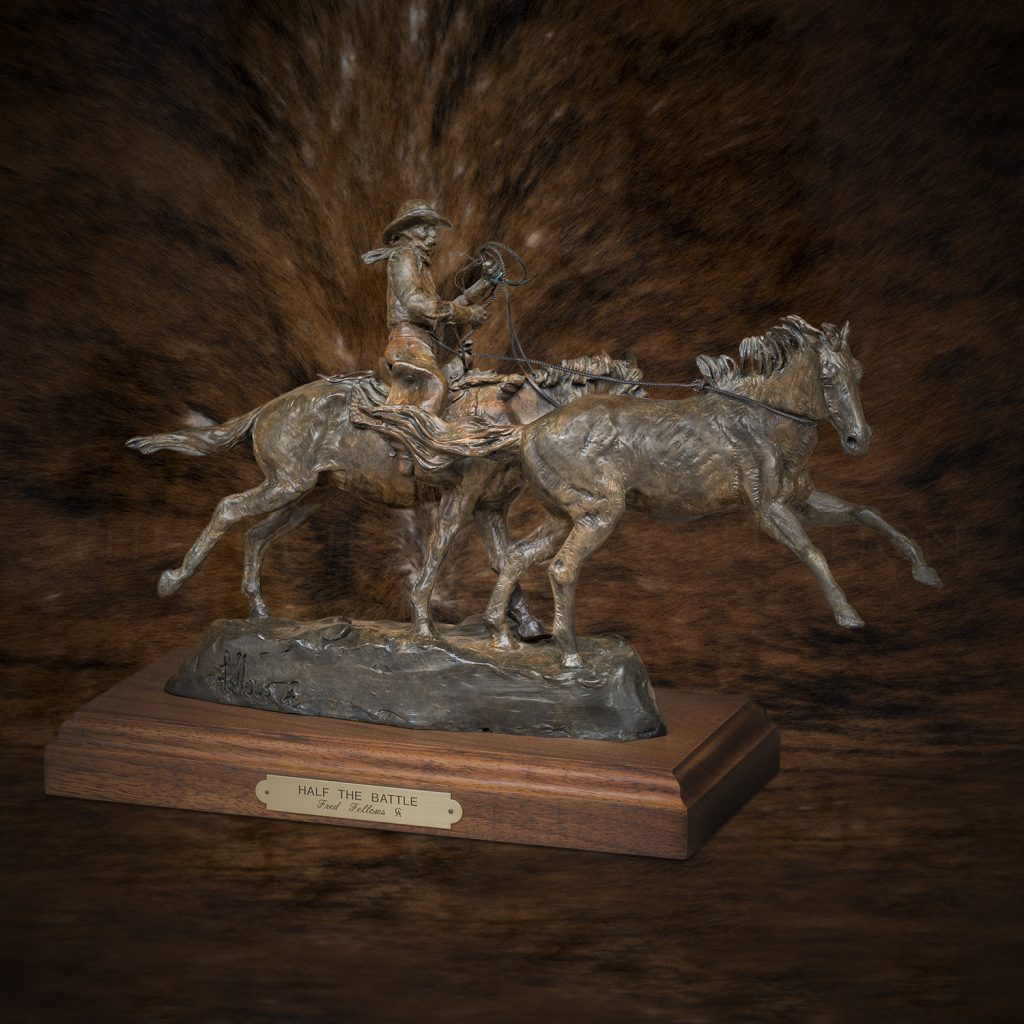 Bronze (1998) | Dimensions: 12”h x 19”w x 7”d
Bronze (1998) | Dimensions: 12”h x 19”w x 7”dWith as much time as Fred Fellows has spent in the saddle and by bringing that knowledge into his work, he achieves a true sense of authenticity in his bronzes. On the Fellows Studios website, he shares “A cowboy that ropes a thousand-pound horse has his work cut out for him. Just getting his rope on the horse is half the battle. Dealing with the ensuing fight is the rest of the battle.”
What are your thoughts when you ponder the enormity of that task?
Half the Battle
Artist: Fred Fellows, CA Emeritus (b. 1934)
With as much time as Fred Fellows has spent in the saddle and by bringing that knowledge into his work, he achieves a true sense of authenticity in his bronzes. On the Fellows Studios website, he shares “A cowboy that ropes a thousand-pound horse has his work cut out for him. Just getting his rope on the horse is half the battle. Dealing with the ensuing fight is the rest of the battle.”
What are your thoughts when you ponder the enormity of that task?
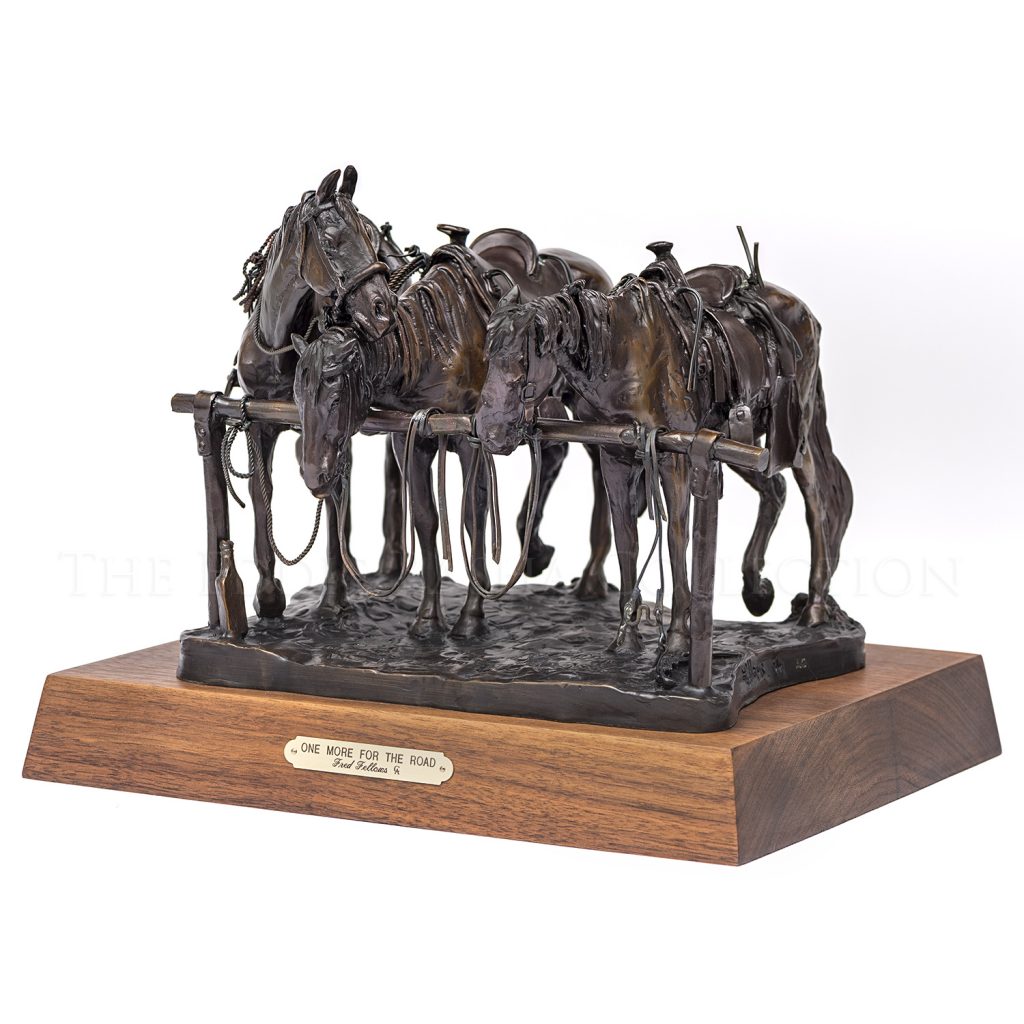 Bronze (1995) | Dimensions: 10”h x 12 ½”w x 10 ½” d; Edition AC
Bronze (1995) | Dimensions: 10”h x 12 ½”w x 10 ½” d; Edition ACFred Fellows has worked with horses in some capacity or another much of his life and is adept at capturing their moods, subtle nuances and personalities. Here, Fred Fellows shows three cow ponies tied to a hitching post with the one on the far left seemingly reaching toward the other horses as if to intimate that perhaps their riders were having “One More for the Road.”
One More for the Road
Artist: Fred Fellows, CA Emeritus (b. 1934)
Fred Fellows has worked with horses in some capacity or another much of his life and is adept at capturing their moods, subtle nuances and personalities. Here, Fred Fellows shows three cow ponies tied to a hitching post with the one on the far left seemingly reaching toward the other horses as if to intimate that perhaps their riders were having “One More for the Road.”
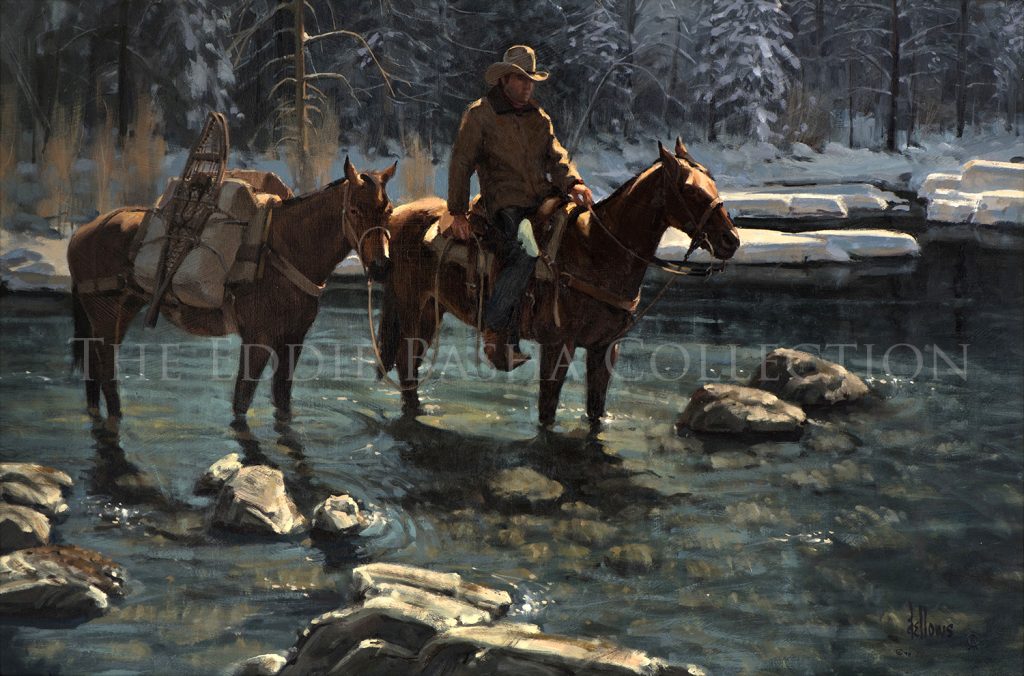 Oil (1978) | Image Size: 20”h x 30”w; Framed Size: 30 ¼”h x 40 ¼”w
Oil (1978) | Image Size: 20”h x 30”w; Framed Size: 30 ¼”h x 40 ¼”wPainting water realistically and effectively is a very difficult task for an artist. It entails capturing the reflective nature of the surface and imparting a feeling of depth which are challenging exercises. Fred Fellows has done so splendidly in this painting of a cowboy and his horses crossing the river. Fellows uses several cool tones of greens and blues to give just the right feel to this winter scene. The rider and horses comprise most of the scene, but the primary features are the beauty of the river and Fellow’s skillful hand at portraying it.
Swan River Crossing
Artist: Fred Fellows, CA Emeritus (b. 1934)
Painting water realistically and effectively is a very difficult task for an artist. It entails capturing the reflective nature of the surface and imparting a feeling of depth which are challenging exercises. Fred Fellows has done so splendidly in this painting of a cowboy and his horses crossing the river. Fellows uses several cool tones of greens and blues to give just the right feel to this winter scene. The rider and horses comprise most of the scene, but the primary features are the beauty of the river and Fellow’s skillful hand at portraying it.
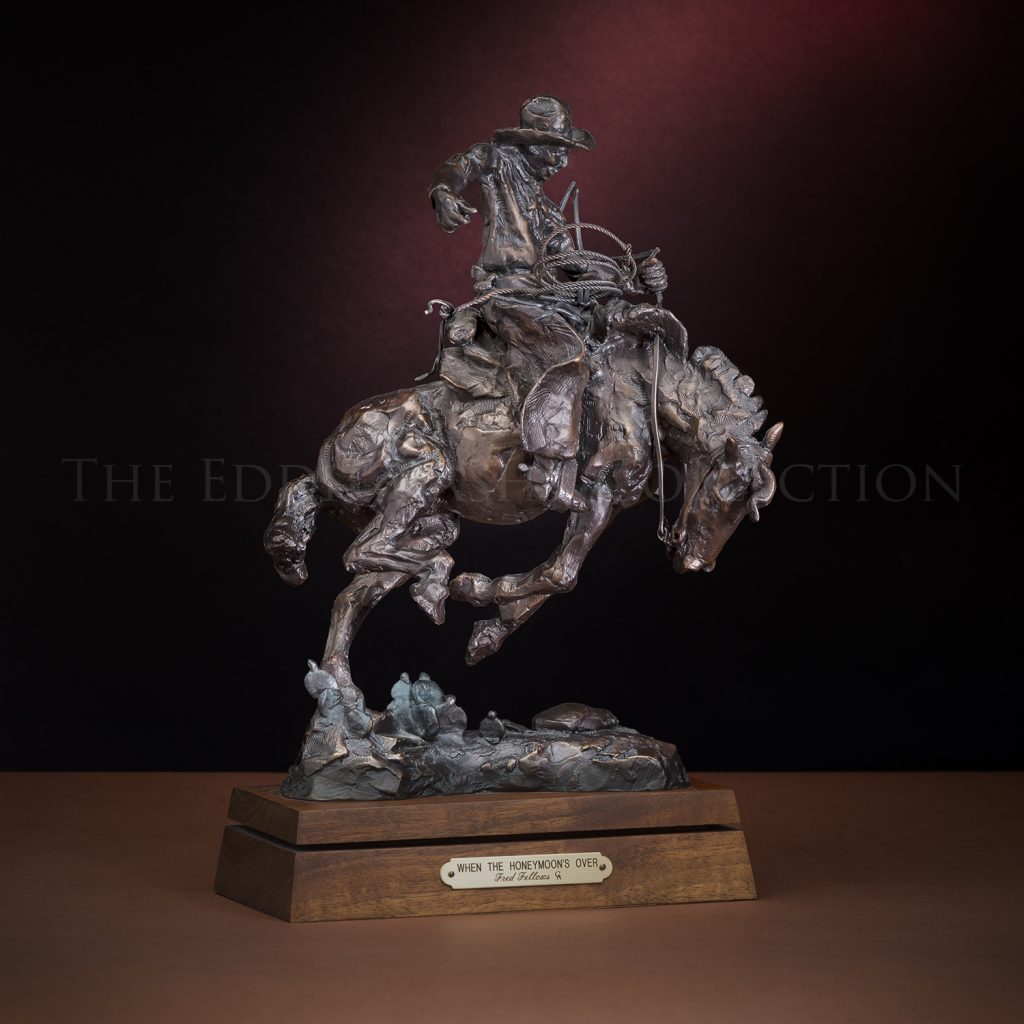 Bronze (1994) | Dimensions: 14”h x 10”w x 5”d; Edition #38 of 100
Bronze (1994) | Dimensions: 14”h x 10”w x 5”d; Edition #38 of 100“Sometimes a cowboy falls in love with a horse and it’s more than he bargained for. When he hits the ground, the honeymoon’s over,” shared Fred Fellows.
Fellows has spent many years as a cowboy and has had the opportunity to observe modern ranch hands for most of his life. A cowboy trying to stay in the saddle on an ornery horse is one of his favorite subjects, one that he handles with an authentic touch and a sense of humor. This particular casting has a rich and lustrous brown patina.
When the Honeymoon’s Over
Artist: Fred Fellows, CA Emeritus (b. 1934)
“Sometimes a cowboy falls in love with a horse and it’s more than he bargained for. When he hits the ground, the honeymoon’s over,” shared Fred Fellows.
Fellows has spent many years as a cowboy and has had the opportunity to observe modern ranch hands for most of his life. A cowboy trying to stay in the saddle on an ornery horse is one of his favorite subjects, one that he handles with an authentic touch and a sense of humor. This particular casting has a rich and lustrous brown patina.
 Pastel (2004) | Image Size: 36”h x 24”w; Framed Size: 46”h x 34”w
Pastel (2004) | Image Size: 36”h x 24”w; Framed Size: 46”h x 34”wOne of the most important rituals practiced by many Northern Plains tribes was the Sundance. In this well done pastel, Fred Fellows presents an Indian wearing a buffalo horn headdress and beaded buckskins preparing to participate in the dance. He holds a sacred buffalo skull which will be an important part of the ritual. The warrior is facing the rising sun. He is drawn in great detail and set against a flat background that serves to emphasize his presence.
Blessing the Sundance Skull
Artist: Fred Fellows, CA Emeritus (b. 1934)
One of the most important rituals practiced by many Northern Plains tribes was the Sundance. In this well done pastel, Fred Fellows presents an Indian wearing a buffalo horn headdress and beaded buckskins preparing to participate in the dance. He holds a sacred buffalo skull which will be an important part of the ritual. The warrior is facing the rising sun. He is drawn in great detail and set against a flat background that serves to emphasize his presence.
 Bronze (1996) | Dimensions: 12”h x 15”w x 9”d; Edition #29 of 100
Bronze (1996) | Dimensions: 12”h x 15”w x 9”d; Edition #29 of 100Having competed in numerous roping competitions, Fred Fellows has a unique insight into creating truly authentic depictions of both the modern and historic west. “A Turn for the Worse” first debuted at the 31st Annual Cowboy Artists of America Show & Sale in 1996 at the Phoenix Art Museum. He and his wife Deborah, an acclaimed artist as well, live on their ranch in Arizona.
A Turn for the Worse
Artist: Fred Fellows, CA Emeritus (b. 1934)
Having competed in numerous roping competitions, Fred Fellows has a unique insight into creating truly authentic depictions of both the modern and historic west. “A Turn for the Worse” first debuted at the 31st Annual Cowboy Artists of America Show & Sale in 1996 at the Phoenix Art Museum. He and his wife Deborah, an acclaimed artist as well, live on their ranch in Arizona.
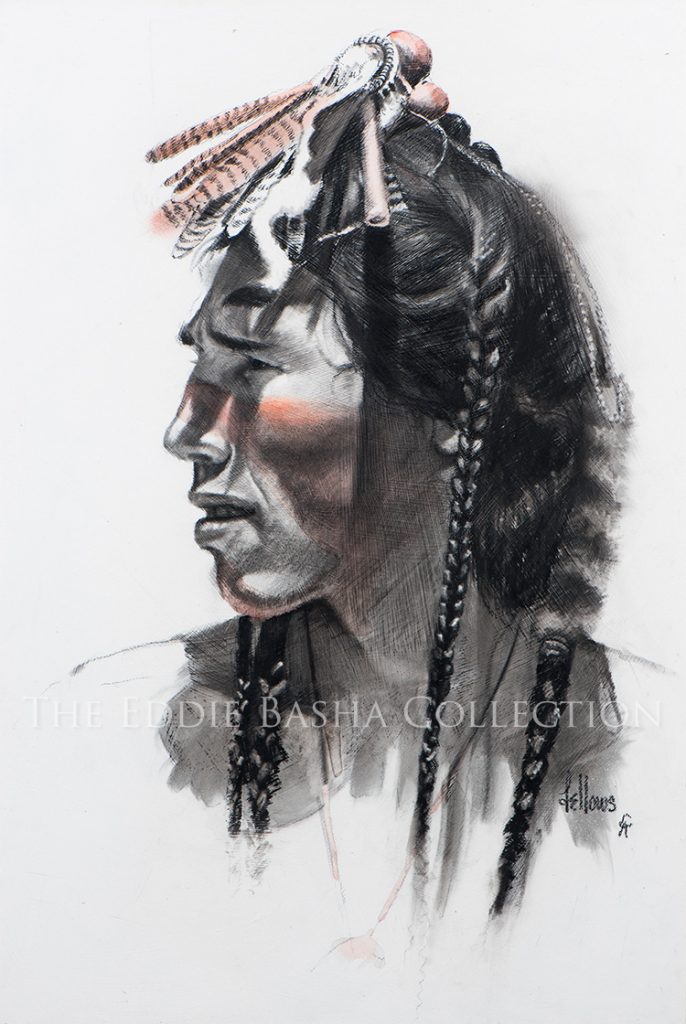 Charcoal (1989) | Image Size: 23”h x 16”w; Framed Size: 33 ¾”h x 26 ½”w
Charcoal (1989) | Image Size: 23”h x 16”w; Framed Size: 33 ¾”h x 26 ½”w“His War Medicine” is an excellent charcoal portrait of a Plains Indian. Shown in profile, the subject’s face is well delineated. Fellows has skillfully drawn a likeness that projects an individual and unique personality with authentic and historically accurate detail.
His War Medicine
Artist: Fred Fellows, CA Emeritus (b. 1934)
“His War Medicine” is an excellent charcoal portrait of a Plains Indian. Shown in profile, the subject’s face is well delineated. Fellows has skillfully drawn a likeness that projects an individual and unique personality with authentic and historically accurate detail.
 Bronze (1985) | 10”h x 7”w x 7”d; Edition #21 of 50
Bronze (1985) | 10”h x 7”w x 7”d; Edition #21 of 50In Ke Ola, Hawai‘i Island’s Community Magazine, Denise Laitinen wrote, “the paniolo, a Hawaiian cowboy, on Hawai‘i Island date back to 1833 when three vaqueros—Spanish/Mexican cowboys—arrived at Kawaihae Harbor to teach Hawaiians how to rope and herd cattle and ride mounted horses. Over the years the paniolo developed their own style of saddle making—known as the Hawaiian tree saddle—so named because cowboys went into the forest and cut the tree, which they carved into a saddle.
And because Mexican saddles were heavy and bulky, the natural instinct of the Hawaiians was to use lighter materials. Thus, they refined the seat to make it concave which was a better fit for its riders’ buttocks. The prototype originated in the early 1900’s and has changed little in the past century. Native Hawaiians came up with a model that was hard to improve upon.”
Fred Fellows, learned early on in life how to ride, rope cattle and build saddles. Given his background, it was only fitting that he sculpted a saddle series which included those used by the Paniolo.
Paniolo Saddle
Artist: Fred Fellows, CA Emeritus (b. 1934)
In Ke Ola, Hawai‘i Island’s Community Magazine, Denise Laitinen wrote, “the paniolo, a Hawaiian cowboy, on Hawai‘i Island date back to 1833 when three vaqueros—Spanish/Mexican cowboys—arrived at Kawaihae Harbor to teach Hawaiians how to rope and herd cattle and ride mounted horses. Over the years the paniolo developed their own style of saddle making—known as the Hawaiian tree saddle—so named because cowboys went into the forest and cut the tree, which they carved into a saddle.
And because Mexican saddles were heavy and bulky, the natural instinct of the Hawaiians was to use lighter materials. Thus, they refined the seat to make it concave which was a better fit for its riders’ buttocks. The prototype originated in the early 1900’s and has changed little in the past century. Native Hawaiians came up with a model that was hard to improve upon.”
Fred Fellows, learned early on in life how to ride, rope cattle and build saddles. Given his background, it was only fitting that he sculpted a saddle series which included those used by the Paniolo.
 Bronze | Dimensions: 9”h x 8”w x 7’d; Artist Proof
Bronze | Dimensions: 9”h x 8”w x 7’d; Artist ProofHorses and men can be a beautiful combination or they can be a disaster depending upon the rider’s skill and horse temperament. Fred Fellow’s “End of a Love Affair” shows an unlucky cowboy who has met a common fate, being bucked off an unruly mount. The cowboy has literally been turned topsy-turvy while his horse continues to buck. Fellows, with a background in ranch work, knows this predicament well and has captured the action with a flair for the dramatic.
End of a Love Affair
Artist: Fred Fellows, CA Emeritus (b. 1934)
Horses and men can be a beautiful combination or they can be a disaster depending upon the rider’s skill and horse temperament. Fred Fellow’s “End of a Love Affair” shows an unlucky cowboy who has met a common fate, being bucked off an unruly mount. The cowboy has literally been turned topsy-turvy while his horse continues to buck. Fellows, with a background in ranch work, knows this predicament well and has captured the action with a flair for the dramatic.
 Oil (2008) | Image Size: 18”h x 30”w; Framed Size: 25 3/8”h x 37”w
Oil (2008) | Image Size: 18”h x 30”w; Framed Size: 25 3/8”h x 37”wOne of Fred Fellows favorite themes is the different modes of transportation in the historic and modern West. He frequently paints stage coaches, chuck wagons, freight wagons, and in this case, a covered wagon that will haul provisions from a desert trading post. The painting shows a wagon drawn by two horses traveling across an expanse of desert with a butte in the distance. The Navajo driver is bundled up against the winter chill as was Fred Fellows when he captured the image with his camera which he later painted back in the warmth of his studio. It is a simple scene, but is an important part of the life on a reservation.
A Trip to the Trading Post
Artist: Fred Fellows, CA Emeritus (b. 1934)
One of Fred Fellows favorite themes is the different modes of transportation in the historic and modern West. He frequently paints stage coaches, chuck wagons, freight wagons, and in this case, a covered wagon that will haul provisions from a desert trading post. The painting shows a wagon drawn by two horses traveling across an expanse of desert with a butte in the distance. The Navajo driver is bundled up against the winter chill as was Fred Fellows when he captured the image with his camera which he later painted back in the warmth of his studio. It is a simple scene, but is an important part of the life on a reservation.
 Bronze | 9”h x 8”w x 9”d; Edition #39 of 100
Bronze | 9”h x 8”w x 9”d; Edition #39 of 100The Big 50
Artist: Fred Fellows, CA Emeritus (b. 1934)
 Opaque Watercolor (2005) | Image Size: 13” x 19”; Framed Size: 28 ¼”w x 22 ¾”h
Opaque Watercolor (2005) | Image Size: 13” x 19”; Framed Size: 28 ¼”w x 22 ¾”hTo Fight Custer
Artist: Fred Fellows, CA Emeritus (b. 1934)
 Bronze | 7.5” x 8” x 12”; Edition #31 of 100
Bronze | 7.5” x 8” x 12”; Edition #31 of 100Celebrating a Business Deal
Artist: Fred Fellows, CA Emeritus (b. 1934)
 Oil Painting (2008) | Image Size: 24”h x 36”w; Framed Size: 34.25”h x 46.25”w
Oil Painting (2008) | Image Size: 24”h x 36”w; Framed Size: 34.25”h x 46.25”wCowboy Artists of America Emeritus Member, Fred Fellows, knows his way around a working ranch and he also knows horse flesh. Both in his bronzes and in his paintings, he expertly captures the muscle tone and confirmation of the horses he portrays. He is equally adept at depicting horses in action or in quiet repose, such as in this scene of three horses waiting in the snow outside a cabin in the mountains. He also excels in this scene at showing the way light reflects off the snow to produce a luminous effect.
“Friends for Supper” made its debut at the 43rd Annual Cowboy Artists of America Show & Sale in 2008 at the Phoenix Art Museum.
Friends for Supper
Artist: Fred Fellows, CA Emeritus (b. 1934)
Cowboy Artists of America Emeritus Member, Fred Fellows, knows his way around a working ranch and he also knows horse flesh. Both in his bronzes and in his paintings, he expertly captures the muscle tone and confirmation of the horses he portrays. He is equally adept at depicting horses in action or in quiet repose, such as in this scene of three horses waiting in the snow outside a cabin in the mountains. He also excels in this scene at showing the way light reflects off the snow to produce a luminous effect.
“Friends for Supper” made its debut at the 43rd Annual Cowboy Artists of America Show & Sale in 2008 at the Phoenix Art Museum.